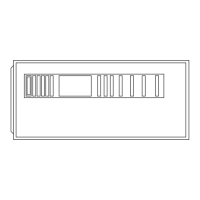PROPERTY DAMAGE
Failure to follow this caution may result in dripping conden-
sate and potential property damage.
When combustion-air pipe is installed above a suspended
ceiling, pipe must be insulated with 3/8-in. thick Armaflex-
type insulation. Combustion-air pipe should also be insulated
when it passes through warm, humid space.
An abandoned masonry chimney may be used as a raceway for
properly insulated and supported combustion-air and vent pipes.
Each furnace must have its own set of combustion-air and vent
pipes and be terminated individually, as shown in Fig. 42.
Other gas appliances with their own venting system may also use
the abandoned chimney as a raceway providing it is permitted by
local code, the NFGC or NSCNGPIC, and the vent or liner
manufacturer’s installation instructions. Care must be taken to
prevent the exhaust gases from one appliance from contaminating
the combustion air of other gas appliances.
UNIT MAY NOT OPERATE
Failure to follow this caution may result in intermittent unit
operation.
When vent pipe is exposed to temperatures below freezing,
such as when it passes through an unheated space or when a
chimney is used as a raceway, pipe must be insulated as
shown in Table 8 with Armaflex-type insulation.
UNIT CORROSION HAZARD
Excessive exposure to contaminated combustion air may
result in safety and performance related problems.
Combustion air must not be taken from inside structure
because inside air is frequently contaminated by halogens,
which include fluorides, chlorides, bromides, and iodides.
These elements are found in aerosols, detergents, bleaches,
cleaning solvents, salts, air fresheners, adhesives, paint, and
other household products. Locate combustion-air inlet as far
as possible from swimming pool and swimming pool pump
house.
FIRE AND EXPLOSION HAZARD
Failure to follow this warning could result in fire, property
damage, personal injury, or death.
Solvent cements are combustible. Keep away from heat,
sparks, and open flame. Use only in well-ventilated areas.
Avoid breathing in vapor or allowing contact with skin or
eyes.
CARBON MONOXIDE/PROPERTY DAMAGE
Failure to follow this warning could result in property
damage, personal injury, or death.
All combustion-air and vent pipes must be airtight and
watertight. Pipes must also terminate exactly as shown in Fig.
36, 37, 38, 39, or 40.
NOTE: The minimum combustion-air and vent pipe length (each)
for these furnaces is 5 ft. Short pipe lengths (5-8 ft) may discharge
water droplets. These droplets may be undesirable, and a 12-in.
minimum offset pipe section is recommended, as shown in Fig. 34,
to reduce excessive droplets from exiting vent pipe outlet.
Combustion-Air and Vent Pipe Diameter
Determine combustion-air and vent pipe diameter.
1. Using Table 7, individually determine the smallest
combustion-air and vent pipe diameters permitted for each
pipe. Pick the larger of these 2 pipe diameters and use this
diameter for both combustion-air and vent pipes.
2. When installing vent systems of short pipe length, use the
smallest allowable pipe diameter. Do not use pipe size greater
than required becuase incomplete combustion, flame distur-
bance, or flame sense lockout may occur.
NOTE: Do not count elbows or pipe sections in terminations or
within furnace. See shaded areas in Fig. 36, 37, 38, 39, and 40.
EXAMPLE: An 080-12 size furnace located in Indianapo-
lis, elevation 650 ft above sea level, could be installed in an
application requiring 3 elbows and 32 ft of vent pipe, along
with 5 elbows and 34 ft of combustion-air pipe. Table 7
indicates this application would allow a 2-in. diameter vent
pipe, but require a 2-1/2 in. diameter combustion air pipe
(2-in. pipe is good for 35 ft with 3 elbows, but only 30 ft
with 5 elbows). Therefore, 2-1/2 in. diameter pipe must be
used for both vent and combustion-air pipes since larger
required diameter must always be used for both pipes. If
same installation were in Albuquerque, elevation 5250 ft
above sea level, installation would require 2-1/2 in. vent
pipe and combustion-air pipe. At 5001- to 6000-ft eleva-
tion, 2-in. pipe is only good for 17 ft with 5 elbows, and
2-1/2 in. pipe is good for 70 ft with 5 elbows.
Combustion-Air and Vent Pipe Attachment
NOTE: All pipe joints must be cemented except attachment of
combustion-air pipe to inlet housing connection, since it may be
necessary to remove pipe for servicing.
1. Attach combustion-air pipe as follows:
a. Determine location of combustion-air intake pipe connec-
tion to combustion-air intake housing as shown in Fig. 33
for application.
b. Reposition combustion-air intake housing plug fitting in
appropriate unused intake housing connection.
Fig. 32—Combustion-Air and Vent Pipe Diameter
Transition Location and Elbow Configuration
A93034
FURNACE
PIPE DIAMETER
TRANSITION IN
VERTICAL SECTION
NOT IN
HORIZONTAL
SECTION
25
→

